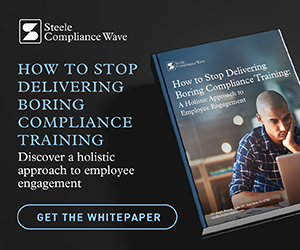 Employees often go into their annual compliance training with the expectation that the sessions will be both dull and irrelevant to them. They might have trouble imagining that they could ever be in a difficult situation or that what they might naturally do could be at odds with what’s right. Unfortunately, annual compliance training events tend to reinforce these low expectations.
Employees often go into their annual compliance training with the expectation that the sessions will be both dull and irrelevant to them. They might have trouble imagining that they could ever be in a difficult situation or that what they might naturally do could be at odds with what’s right. Unfortunately, annual compliance training events tend to reinforce these low expectations.
More and more compliance and ethics professionals are realizing it’s important to supplement compliance training with at least some type of short-form communication. To use these short, frequent communications effectively, it’s helpful to understand why annual training events fall short.
3 Reasons Why Annual Compliance Training Isn’t Enough
- Too Much Information To Absorb And Retain
If you have to deliver all of your compliance messaging in a single annual training event, it’s almost certainly too much information for anyone to absorb and incorporate into their understanding (let alone their behavior). Overloading your audience with too much information is a sure way to lose their attention and obscure the message you need to convey.
Even if you manage to engage employees so that they don’t tune out during compliance training, there’s the problem of retaining that information. The “forgetting curve” attempts to show how people lose information over time when they make no attempts to retain it. Hermann Ebbinghaus, who formulated the forgetting curve in 1885, suggested that repetition based in active recall (especially spaced repetition) was effective in overcoming this rapid forgetting.
Suffice it to say, if you have an annual training on company policies in January with no attempt to reinforce that learning, employees are likely to have lost much of that knowledge by June or July.
- Lack Of Responsiveness To Emerging Issues
Compliance issues and risks are always changing, and annual training alone doesn’t allow you to respond to new situations and needs. If an important compliance issue comes up mid-year, you probably can’t afford to wait six months before training employees. You need some way to communicate in real time, preferably with risk-based communications that are relevant to the compliance risks faced by a specific audience.
Beyond the need to handle compliance issues as they arise, annual training doesn’t give you the ability to provide just-in-time training. Let’s say you have an employee in the U.S. who is being sent to work on-site in Brazil. Providing that employee with the relevant tools and training before their trip allows you to head off compliance risks before they become a problem.
This specific training wouldn’t be nearly as effective if presented in an annual training. An employee who doesn’t expect to go to Brazil would likely dismiss such training as hypothetical or irrelevant. Proactive, just-in-time training helps protect your company from significant liabilities and empowers employees to conduct business in an ethical, compliant and profitable manner.
- Disruption Instead Of Integration
Long-form training certainly has its place, but it’s a disruption to the normal workday. When you limit compliance training to an annual block of dedicated time, those concepts take place in a context that’s separate from an employee’s everyday work mindset. If you deliver compliance communication in quick touches throughout the year, using a variety of formats, employees are much more likely to integrate those concepts as part of the company culture.
A Communication Strategy That Drives Behavior-Change
As the reasons above show, today’s compliance professionals need to look beyond annual training events alone. The solution is to implement a holistic compliance communication program that draws on behavior-change science and includes ongoing content across many different modalities and formats.
Incorporating multimedia, multi-modal communications provides more opportunities for learning and retaining compliance information. This ongoing approach accommodates a broad range of learning styles, resulting in a more effective compliance program.
Ready to engage and empower your employees with a dynamic compliance communication plan? Download our free report, “5 Ways To Increase The Effectiveness Of Your Compliance Communications.”



